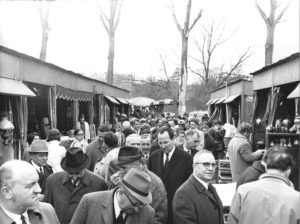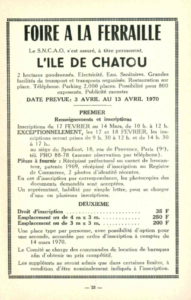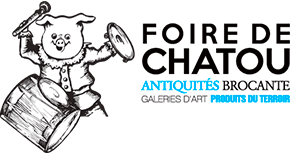Brief history of the National Antiques Fair, Flea Market,
Art Galleries and Local Products

The picturesque history of this event gives color and spirit to this great flea market.
The Ham Fair was created on its own in the Middle Ages, probably even before, because France has an old “charcuterie” tradition.
It was the great Gallic specialty. The Gallic herds of pigs were admired by the Romans, who enthusiastically cited Bayonne ham, cerdagne and Franche-Comté pork meats, etc.
Until the 19th century, pork was the staple food for Christmas Eve: it was the king of the feast among peasants as well as among bourgeois and nobles.
During the Middle Ages, butchers from all provinces used to come to Paris during Holy Week to sell their prepared meats. They settled where there were the most customers, around Notre-Dame, certain of having those who attended services as loyal customers. The merchants were more and more numerous because the profession of butcher was free. The freedom of movement given to pigs was suppressed by King Louis Le Gros, his son Philippe having suffered a fatal fall from his horse caused by a pig. Only the “Antonines” belonging to the monks of Saint-Antoine were still allowed to circulate. All the others were collected and given to the Hôtel-Dieu for the sick. In 1451, we began to regulate this Lard Fair and bad meats were thrown into the Seine. From 1500, it became too important for its location and, over the following years, the Fair moved successively to rue des Prouvaires, Place de l’Hotel de Ville, Place de la Morgue (today Place de la Concorde).
In 1789 and during the Revolution and the Terror, the Lard Fair disappears.
In 1804, a decree revived it under the name of Foire aux Jambons, it returned near Notre-Dame and Place de la Cité.
In 1813, an ordinance sent him to Quai de la Vallée (now Quai des Grands-Augustins); in 1832, it moved to rue du Faubourg Saint-Martin to the site of the old forage store.
Finally in 1840, the Fair settled on Boulevard Bourdon. There will be added many dealers selling bric-a-brac, old clothes, old scrap metal.
The Scrap Fair was born and its fate was now linked to that of the Ham Fair, which it was to quickly overtake in importance.
In 1869, a police order transferred the two markets on Boulevard Richard-Lenoir, which they were not to leave for nearly a century, from Palm Sunday to Easter Sunday until 1940, then after the war twice a year. year, spring and fall.
Underlying, the problems of location, access, circulation are resurfacing again. Awareness was taken of an impending mutation.
The Syndicat National du Commerce de l’Antiquité et de l’Occasion will present numerous transfer projects. Everything was postponed.

In 1969, without prior consultation with the profession, the Police Prefecture moved the Fair to the Beaubourg plateau and, on February 2, 1970, the Paris Prefect informed the S.N.C.A.O. that, upon deliberation by the Council of Paris, the Scrap and Ham Fair could be transferred outside the capital.
The leaders of the National Trade Union of Antiquity and Occasion immediately undertook the necessary rescue operation. It was carried out smoothly, and with the help of the Municipality of Chatou, we were able to ensure the sustainability of the most famous Brocante Fair in France.
This is how Parisians find, in an impressionist atmosphere, twice a year, the Brocante and Ham Fair in Chatou (second half of March and end of September), this living testimony of the past where the history of flea market continues in the Bataclan, Chemin-Vert and Boulevard Richard-Lenoir alleys.

